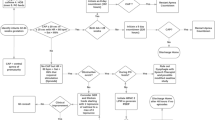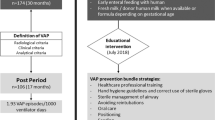Abstract
Objective
Evidence suggests that antibiotics are unnecessary in infants with transient tachypnea of the newborn (TTN) that are low-risk for early-onset sepsis. The aim was to reduce ampicillin and gentamicin days of therapy (DOT) in infants with suspected TTN by 10% within 12 months.
Study design
We used the Model for Improvement to test interventions from August 2019 to September 2021 to decrease antibiotic utilization in low-risk infants with TTN. Interventions included the creation of an evidence-based clinical pathway, admission huddles, and prescriber audit and feedback.
Results
We reduced ampicillin and gentamicin use by 26% and 23%, respectively. In 123 infants with suspected TTN, we sequentially decreased starting antibiotics in this group from 71% to 41%, 13% and 0%. There were no cases of missed bacteremia.
Conclusion
Creation of a multidisciplinary antimicrobial stewardship QI team and subsequent interventions were successful in safely reducing antibiotic use in infants with TTN.
This is a preview of subscription content, access via your institution
Access options
Subscribe to this journal
Receive 12 print issues and online access
$259.00 per year
only $21.58 per issue
Buy this article
- Purchase on Springer Link
- Instant access to full article PDF
Prices may be subject to local taxes which are calculated during checkout




Similar content being viewed by others
References
Grohskopf LA, Huskins WC, Sinkowitz-Cochran RL, Levine GL, Goldmann DA, Jarvis WR, et al. Use of antimicrobial agents in United States neonatal and pediatric intensive care patients. Pediatr Infect Dis J. 2005;24:766–73.
Escobar GJ, Puopolo KM, Wi S, Turk BJ, Kuzniewicz MW, Walsh EM, et al. Stratification of risk of early-onset sepsis in newborns ≥ 34 weeks’ gestation. Pediatrics. 2014;133:30–6.
Clark RH, Bloom BT, Spitzer AR, Gerstmann DR. Reported medication use in the neonatal intensive care unit: data from a large national data set. Pediatrics. 2006;117:1979–87.
Ho T, Buus-Frank ME, Edwards EM, Morrow KA, Ferrelli K, Srinivasan A, et al. Adherence of newborn-specific antibiotic stewardship programs to CDC recommendations. Pediatrics. 2018;142:e20174322.
Schulman J, Dimand RJ, Lee HC, Duenas GV, Bennett MV, Gould JB. Neonatal intensive care unit antibiotic use. Pediatrics. 2015;135:826–33.
Patel SJ, Saiman L. Antibiotic resistance in neonatal intensive care unit pathogens: mechanisms, clinical impact, and prevention including antibiotic stewardship. Clin Perinatol. 2010;37:547–63.
Kuppala VS, Meinzen-Derr J, Morrow AL, Schibler KR. Prolonged initial empirical antibiotic treatment is associated with adverse outcomes in premature infants. J Pediatr. 2011;159:720–5.
Cotten CM, Taylor S, Stoll B, Goldberg RN, Hansen NI, Sánchez PJ, et al. Prolonged duration of initial empirical antibiotic treatment is associated with increased rates of necrotizing enterocolitis and death for extremely low birth weight infants. Pediatrics. 2009;123:58–66.
Arnold C. Decreasing antibiotic overuse in neonatal intensive care units: quality improvement research. Proc Bayl Univ Med Cent. 2005;18:280–4.
America SfHEo, America IDSo, Society PID. Policy statement on antimicrobial stewardship by the Society for Healthcare Epidemiology of America (SHEA), the Infectious Diseases Society of America (IDSA), and the Pediatric Infectious Diseases Society (PIDS). Infect Control Hosp Epidemiol. 2012;33:322–7.
Weintraub AS, Cadet CT, Perez R, DeLorenzo E, Holzman IR, Stroustrup A. Antibiotic use in newborns with transient tachypnea of the newborn. Neonatology. 2013;103:235–40.
Li J, Wu J, Du L, Hu Y, Yang X, Mu D, et al. Different antibiotic strategies in transient tachypnea of the newborn: an ambispective cohort study. Eur J Pediatr. 2015;174:1217–23.
Dehdashtian M, Aletayeb M, Malakian A, Aramesh MR, Malvandi H. Clinical course in infants diagnosed with transient tachypnea of newborn: A clinical trial assessing the role of conservative versus conventional management. J Chin Med Assoc. 2018;81:183–6.
Salama H, Abughalwa M, Taha S, Sharaf N, Mansour A. Transient tachypnea of the newborn: is empiric antimicrobial therapy needed? J Neonatal Perinat Med. 2013;6:237–41.
Sabzehei MK, Basiri B, Shokouhi M, Poorolajal J, Bahadorbeigi L. Evaluating the need for prophylactic antibiotic therapy in infants with transient tachypnea of the newborn: a triple-blind randomized clinical trial study. Int J Pediatrics. 2018;6:8086–92.
Meyers JM, Tulloch J, Brown K, Caserta MT, D’Angio CT, TEAM GCSHNAS. A quality improvement initiative to optimize antibiotic use in a level 4 NICU. Pediatrics. 2020;146:e20193956.
Cantey JB, Patel SJ. Antimicrobial stewardship in the NICU. Infect Dis Clin North Am. 2014;28:247–61.
Nzegwu NI, Rychalsky MR, Nallu LA, Song X, Deng Y, Natusch AM, et al. Implementation of an antimicrobial stewardship program in a neonatal intensive care unit. Infect Control Hosp Epidemiol. 2017;38:1137–43.
Provost L, Murray S. The health care data guide: learning from data for improvement. San Francisco, CA: Jossey-Bass; 2011. 480 p.
Shah A. Using data for improvement. BMJ. 2019;364:l189.
Patel SJ, Saiman L, Duchon JM, Evans D, Ferng YH, Larson E. Development of an antimicrobial stewardship intervention using a model of actionable feedback. Interdiscip Perspect Infect Dis. 2012;2012:150367.
O’Leary EN, van Santen KL, Edwards EM, Braun D, Buus-Frank ME, Edwards JR, et al. Using NHSN’s antimicrobial use option to monitor and improve antibiotic stewardship in neonates. Hosp Pediatr. 2019;9:340–7.
Pollack LA, Srinivasan A. Core elements of hospital antibiotic stewardship programs from the Centers for Disease Control and Prevention. Clin Infect Dis. 2014;59:S97–100.
Puopolo KM, Benitz WE, Zaoutis TE, NEWBORN COFA, DISEASES COI. Management of neonates born at ≤34 6/7 weeks’ gestation with suspected or proven early-onset bacterial sepsis. Pediatrics. 2018;142:e20182896.
Moehring RW, Dodds Ashley ES, Ren X, Lokhnygina Y, Baker AW, Jones TM, et al. Denominator matters in estimating antimicrobial use: a comparison of days present and patient days. Infect Control Hosp Epidemiol. 2018;39:612–5.
Reichman V, Brachio SS, Madu CR, Montoya-Williams D, Peña MM. Using rising tides to lift all boats: equity-focused quality improvement as a tool to reduce neonatal health disparities. Semin Fetal Neonatal Med. 2021;26:101198.
Acknowledgements
We thank all the members of this ASP QI initiative, and the attending, fellow, NP, RN, and clinical pharmacy staff in the Alexandra Cohen NICU at NYP-Weill Cornell for their dedication and enthusiasm for antimicrobial stewardship.
Author information
Authors and Affiliations
Contributions
LS assisted with study design, performed data collection and preparation, analyzed the data, drafted the initial manuscript, and critically reviewed and revised the manuscript. LB, GG, and SV assisted with data collection and critically reviewed the manuscript. JH, SH, VY, and KA contributed to study design and critically reviewed the manuscript. SO assisted with data analysis and preparation and critically reviewed the manuscript. PT conceptualized and designed the study, performed data collection and preparation, analyzed the data, and critically reviewed and revised the manuscript. All authors reviewed and approved the final manuscript as submitted and agree to be accountable for all aspects of the work.
Corresponding author
Ethics declarations
Competing interests
The authors declare no competing interests.
Ethics approval
The Weill Cornell Medicine Institutional Review Board (IRB) approved this study with a waiver of informed consent, and it was considered exempt by the IRB since it represented QI.
Additional information
Publisher’s note Springer Nature remains neutral with regard to jurisdictional claims in published maps and institutional affiliations.
Supplementary information
Rights and permissions
Springer Nature or its licensor (e.g. a society or other partner) holds exclusive rights to this article under a publishing agreement with the author(s) or other rightsholder(s); author self-archiving of the accepted manuscript version of this article is solely governed by the terms of such publishing agreement and applicable law.
About this article
Cite this article
Senaldi, L., Blatt, L., Han, JY. et al. A quality improvement initiative to reduce antibiotic use in transient tachypnea of the newborn. J Perinatol 44, 119–124 (2024). https://doi.org/10.1038/s41372-023-01850-x
Received:
Revised:
Accepted:
Published:
Issue Date:
DOI: https://doi.org/10.1038/s41372-023-01850-x
This article is cited by
-
Thoracic fluid content (TFC) using electrical cardiometry versus lung ultrasound in the diagnosis of transient tachypnea of newborn
European Journal of Pediatrics (2024)



